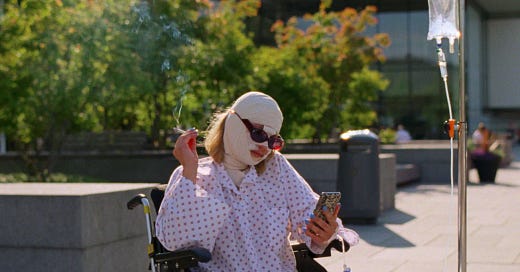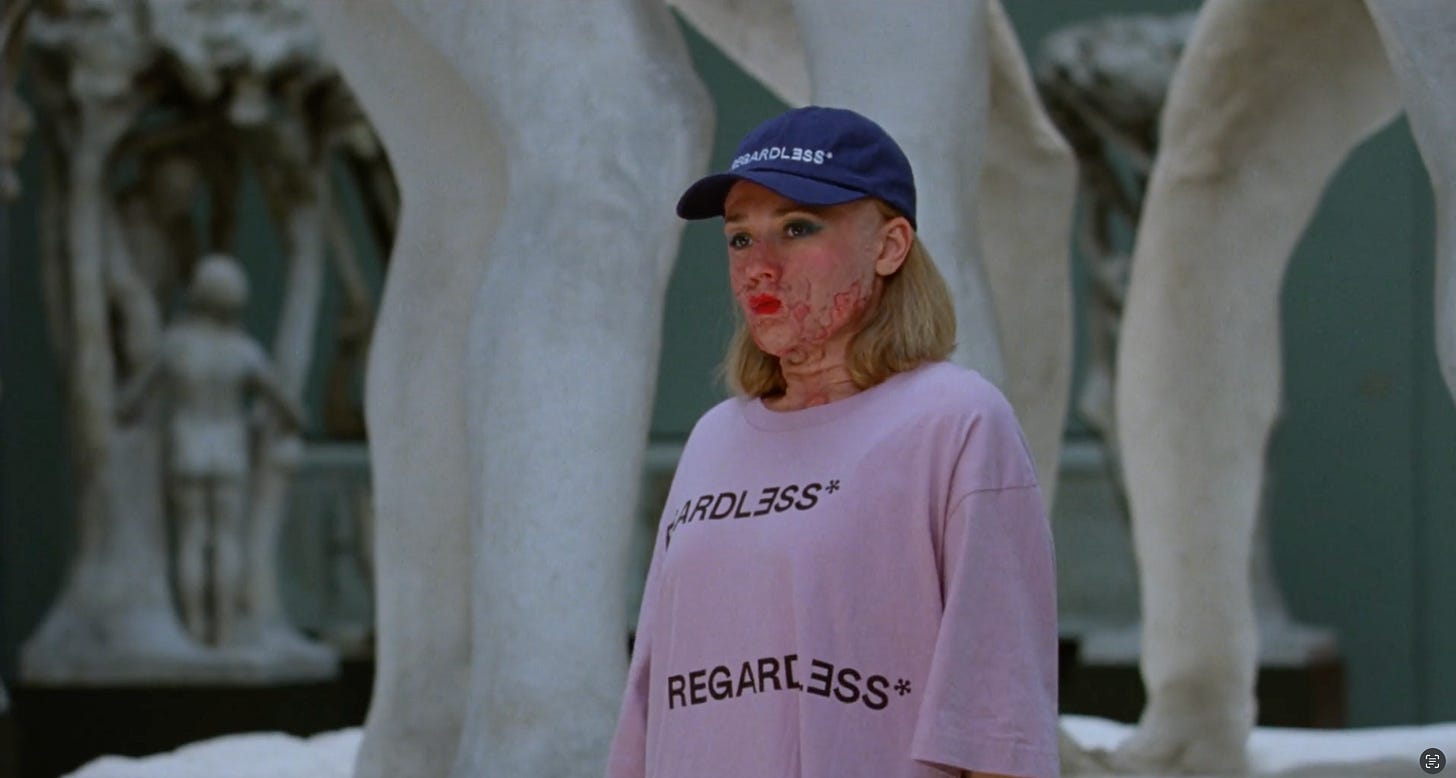How to Weaponize Sickness for Attention and Exploit People’s Empathy
Caring for someone vs being careful around them
The Norwegian dark comedy film Sick of Myself follows Signe, a young barista who desperately wants people to adore her. When her boyfriend gains attention in the local art scene, she’s too jealous to celebrate with him and his friends. She feels like people don’t recognize her natural talents and charisma. This begins to change when a dog violently bites a woman’s throat outside the coffee shop where Signe works. The profusely bleeding woman stumbles into the shop and slumps into Signe’s arms. Signe is too stunned to do anything other than hold the woman’s neck. The paramedics arrive and ask Signe, “Are you OK? Are you injured?” Signe doesn’t answer at first because she’s transfixed by how many people are staring worriedly at her bloody shirt and face. Finally, people see me. This experience implants an idea – a dangerous and selfish idea that only a sick person could have.
Signe comes across an article while scrolling social media with the headline, “Skin Disease Linked to Russian Drug ‘Lidexol.’” The article includes shocking images of women who had taken the anxiety medication. They are covered in clumpy raised scars that are purple and oozing. A healthy person would be horrified, but Signe is jealous. She wants her picture in the news. She contacts an old drug dealer friend, asks him to find her a supply of Lidexol, and starts taking the drug at extremely high doses. Visible scars and rashes develop on her body. To her delight, people begin to notice.
Her boyfriend is more concerned about her than usual. Her friends listen intently to her lies and complaints about her health. She claims to be suffering from an unknown sickness (one too special to be common). A journalist friend publishes an interview about her sickness titled, “Stricken with Mystery.” The photos in the article catch the eye of an executive at a “progressive” modeling agency.
Exec: These photos, they're fantastic.
Signe: Thanks. I directed them myself, kind of.
Exec: Really? Is what I see on your face represented on your body as well?
Signe: Yes. Mostly on the upper body.
Exec: I think it's beautiful. Really.
Signe: You think? Thanks.
Exec: I’ve worked in fashion my entire adult life. At some point, I got so fed up. All those skinny bodies and symmetrical faces... I was sick and tired of it.
Signe: I know what you mean.
Exec: So, when I started an agency, I wanted to do it differently and focus on inclusivity.
Signe: It's about time.
Exec: Right? Globally, l'm not the first. But in Scandinavia, no one in this business is as forward-looking as me. I want to advance a culture where people like you don't get discriminated. Does your disease have a name?
Signe: No, they haven't managed to diagnose it yet. But...
Exec: Does it affect your health?
Signe: No, apart from how I look, I'm healthy.
This exchange cleverly plays with the film’s sickness motif. The executive says that she’s “sick” of seeing beautiful models. Signe makes herself physically sick because she suffers from the same moral sickness as the executive. Both are jealous of the attention other people receive for their beauty, talent, charisma, etc. The executive’s “forward-looking” “anti-discrimination” campaign coincidentally features sick women that make her look sexier by comparison. Signe claims to be healthy apart from how she looks, but she looks sick because she’s sick on the inside. Both women exploit people’s empathy because they are sick of themselves – sick of not being the kind of people who captivate others’ attention.
Sick of Myself incisively depicts the radical difference between caring for someone and being careful around them. People sick with jealous resentment do not understand this distinction because all attention is the same to them. The dog attack scene represents what happens when sick people gain cultural power. The strangers were looking at Signe rather than the actual victim of the attack who was bleeding out on the floor, representing how narcissistic liars can easily take advantage of the morality of boundless empathy. This naive morality says that the origin of a person’s pain doesn’t matter. It portrays those who condition their empathy as heartless and regressive, forgetting that jealousy and resentment corrupt every human heart.
One need only cover himself in blood to get attention in a boundlessly empathetic culture. He can do this symbolically by developing a “mystery illness” that defies categorization. The symptomatology conveniently changes over time, which means that others can never fully empathize with his condition. Every new symptom is an opportunity to receive more empathy and attention.
If medical malingering isn’t his style, then he can suddenly realize that he has a new cultural identity that changes how others must interact with him if they wish to be nice. Every rule of niceness that he invents is a chance to elicit attention. One method is to identify with a vague identity that has no clear definition because then others can never fully know how to be nice to him that day. They must look at him and ask. Another approach is to frequently identify with new cultural identities, which has the same effect because every new identification imposes an attentional demand on those who still wish to be “nice” to him.
In all cases, it’s best if the stakes are high. People should know that failing to attend to and emotionally validate his symptoms or identities will hurt and potentially traumatize him. He should consider making it a matter of life and death. He should maximize the stakes and threaten to kill himself if people don’t give him the attention he wants in the way that he wants it. This often works wonderfully, securing others’ attention on him and his feelings.
Being “nice” to a person who does these kinds of things is not the same as genuinely caring for him as a person. It’s being careful around him. He’s not being vulnerable, he’s vying for attention. Empathizing with his invented symptoms or identities reinforces his unhealthy belief that he needs to have a new symptom or identity to be loved.
Importantly, such empathy isn’t really empathetic because it relates to the person’s temporarily invented self rather than his true being. It’s easier for most people to empathize with invented pain than with jealous resentment because they want to forget about their own feelings of inadequacy. True empathy in such situations relates to a dark motivation. It says, “I’m sick of myself too.”









Another great piece!
Question— so how do you know when someone is inventing a symptom / condition / identity vs. earnestly having that condition?
If you could know a person is acting in this way, you could not play along with it.
But isn’t this issue prevalent because the “symptom” is convincing? (I.e. people are convinced that there is harm that might be done, and that ‘being nice’ is the best way to act.